How to Identify Bearings by Number? | Basic Calculation
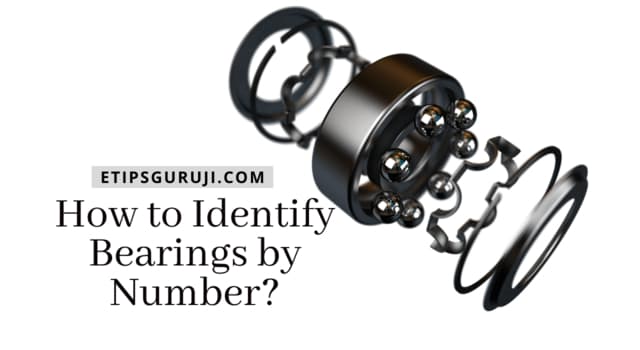
Throughout the world, there are various means by which a bearing is made. So, if you’re looking for “how to identify bearings by number?” then read the entire post. With this post, we are going to discuss all the parameters and types of nomenclature bearing based on various numbering systems.
But before jumping directly on how to identify bearings by number? let’s take a look at the basics of bearing number.
What is a Bearing Number?
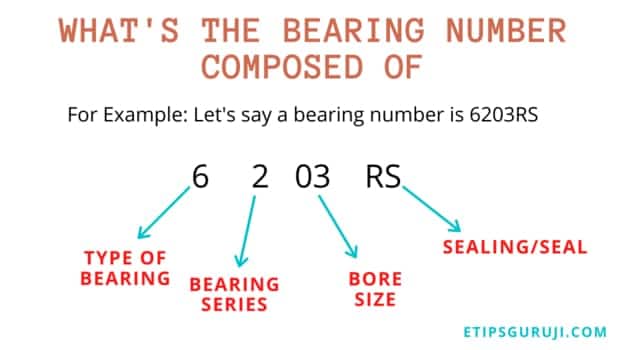
A bearing number itself is made from various other numbers that speak various other aspects of bearing. In general, a bearing number composes the information of bearing types, bearing series, bore size, and sealing.
Therefore, with a bearing number, you not only find the specific type of bearing but also it’s series and bore size number.
For instance, let’s take an example of a specific bearing number 6203RS. In the given bearing number:
- The first number i.e. ‘6’ represents the “type of bearing”.
- The second number i.e. ‘2’ represents the “ bearing series”
- The third and fourth number i.e. “03” represents “bore size”
- And the last two letters i.e. “RS” represents the “Sealing/ Seal”
Also Read:
- Thrust Bearing – 6 Design Types, Working, and Applications
- How to Hotwire a Car? | 3 Best-Known Cheat to Hotwire a Car
How to Identify Bearings by Number?
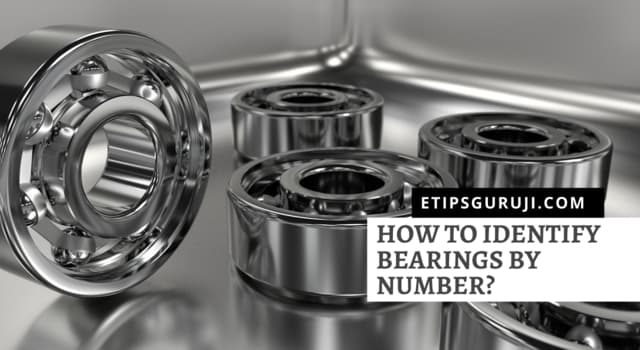
In this section, we are going to discuss how to identify bearings by number? There are basically 4 sections of bearing number. These are:
Types of Bearing Based on Bearing Number
While talking about various types of bearing numbers, in general, there are basically four fundamental bearings. These are
- Radial Ball Bearing
- Radial Roller Bearing
- Thrust Ball Bearing
- Thrust Roller Bearing
Radial Ball Bearing Number
In this type of bearing, the friction load is carried by the radial axis only. Moreover, they operate via the lubricated steel balls that are placed between the grooved rings.
While talking about its other name, they tend to call them deep-groove bearings or Conrad bearings. For instance, they are accommodated in various automobile industries and industrial machinery.
However, the common radial ball bearing numbers are 1, 2, 3, 5, 6, and 7.
Radial Roller Bearing Number
As per the name, they have a rolling element in which the load is placed smartly in between the two races. So, they tend to have relative motion of these races which are finally responsible for rolling with very less resistance force. This also hinders the sliding movement of the radial roller bearing.
The common use of radial roller bearing are:
- Light loads such as bicycles ball bearings
- Heavy loads such as cars and trucks, tapered rolling bearings.
The most common bearing numbers for radial roller bearing are N, NU, NN, 2, and 3.
Thrust Ball Bearing Number
While talking about thrust ball bearing, they have rotatory parts that carry axial loads only. However, they are not built to serve the heavy load machinery. This is why their sizes are small which is about 2mm to 340mm.
In a thrust ball bearing, they have two races that are filled with lubricated bearing balls to carry the axial loads. In this type, the stationary part is attached to one race while the other race governs the movement of the axial loads.
The most common thrust ball bearing number has a ‘5’ bearing number. In addition, you can also check our dedicated post on the thrust bearing from here.
Thrust Roller Bearing Number
While talking about the thrust roller bearing, they have single row, double row, and three-rowed races that can bear the load capacities but only to the axial line. Cylindrical thrust roller bearing and tapered roller thrust bearing are some common and mostly used thrust roller bearings.
These types of bearing have relatively less resistance even when they are on load. This is due to their fine weight distribution system. In general, the most common bearing size of the thrust roller bearing number is ‘2’.
Table of Different Types of Bearing and their Code
The first table on the topic of how to identify bearings by number: Types of bearing and their code.
| S.No. | Bearing Name | Type Code |
|---|---|---|
| 1 | Self Aligning Ball Bearing | 1 |
| 2 | Spherical Roller Bearing | 2 |
| 3 | Double Row Angular Contact Ball Bearing | 3 |
| 4 | Double Row Ball Bearing | 4 |
| 5 | Thrust Ball Bearing | 5 |
| 6 | Single Row Deep Groove Ball Bearing | 6 |
| 7 | Singular Row Angular Contact Bearing | 7 |
| 8 | Felt Seat Bearing | 8 |
| 9 | Tapered Roller Bearing | 32/T |
| 10 | Inch Bearing | R |
| 11 | Cylindrical Roller Bearing | N |
| 12 | Needle Roller Bearing | NA |
| 13 | Double Row Roller Bearing | NN |
| 14 | Needle Roller Bearing With Closed Ends | BK |
| 15 | Needle Roller Bearing With Open Ends | HK |
| 16 | Needle Roller and Cage Thrust Assembly | K |
| 17 | CARB Toroidal Roller Bearings | C |
| 18 | Four Point Contact Bearings | QJ |
Bearing Series and Their Code in Bearing Number
To demonstrate the strength and toughness of a bearing, bearing series is very useful. The toughness of a bearing can be categorized into seven broad categories. These are:
- Very thin section
- Extra thin section
- Heavy
- Medium
- Light
- Extra Light Thrust
- Extra Light
In general, the bearing series code demonstrates by the second digit in the actual bearing number. Hence, the second digit dignified the bearing series.
Table for Bearing Series and Their Code
The second table on the topic of how to identify bearings by number?: Bearing Series and their Code.
| S.No. | Bearing Series | Series Code |
|---|---|---|
| 1 | Extra Light | 0 |
| 2 | Extra Light Thrust | 1 |
| 3 | Light | 2 |
| 4 | Medium | 3 |
| 5 | Heavy | 4 |
| 6 | Extra thin section | 8 |
| 7 | Very thin section | 9 |
Bore Size of Bearing
A bore size or bore diameter is called to be the distance between the inner race (deep grooved wall). They are broadly categorized as fit and tight fit.
While talking about how to find and calculate the bore size of the bearing, it is calculated by the finding of its relevant dimension. The inner race diameter should be measured in millimeters.
With the value of bore diameter, one can ensure the circular fit of bearing for the desired equipment. Therefore, if you require a bearing for the equipment you have to first find the inner diameter of the bore.
In a bearing number, the 3rd and 4th numbers represent the bore size of the bearing. The general bore diameter for a bearing ranges from “00” to “05”
But one point that one should consider is that in case of no four-digit, let’s say ‘624” then the 3rd digit represents the bore size of bearing.
Table of Bore Size and Corresponding Bearing Code
The third table on the topic of how to identify bearings by number? Bore size/ bore diameter along with their corresponding bearing code.
| S.No. | Bore Size/ Diameter | Bearing Code |
|---|---|---|
| 1 | 10 | 00 |
| 2 | 12 | 01 |
| 3 | 15 | 02 |
| 4 | 17 | 03 |
| 5 | 20 | 04 |
| 6 | 25 | 05 |
| 7 | 30 | 06 |
| 8 | After this, Bore size= Code x 5 | 07 |
Shielding or Sealing of Bearing in Bearing Number
In any type of bearing the lubrication is done to reduce the resistivity and also to decrease the wear of the bearing components.
To make lubrication full proof, shielding or sealing is done. That’s why they not only lubricate the bearing but also prevent it from contamination.
Lubrication can be sealed (contact) or a shield (non-contact). But when the bearing has to operate in a vacuum, then no-seal is used. In those cases, the bearing will be externally lubricated.
In a bearing number, a shield/seal/no-seal/ is represented by the two-block alphabets. The following table represents all the common types of shielding or sealing in bearing numbers.
Table of Shielding or Sealing of Bearing in Bearing Number
The fourth table on the topic of how to identify bearings by number? Shielding or Sealing of Bearing in Bearing Number.
| S. No. | Shield/ Seal/Others | Bearing Code |
|---|---|---|
| 1 | Brass Cage | M |
| 2 | One Side Shielded | Z |
| 3 | Both Sides Shielded | ZZ |
| 4 | One Side Sealed | RS |
| 5 | Both Side Sealed | 2RS |
| 6 | One Side Non-Contact Seal | V |
| 7 | Both Sides Non-Contact Seal | VV |
| 8 | Both Sides Contact Seal | DDU |
| 9 | Snap Ring and Groove | NR |
How to Find Bearing Number?
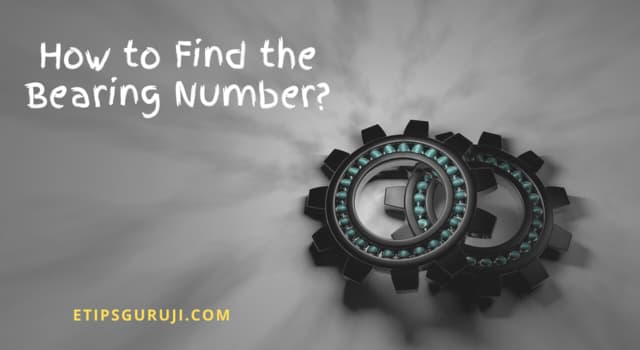
In this section, we are going to discuss how to identify bearings by number using practical tools and measuring instruments.
To find the bearing number, one of the easiest ways is to look for the reference numbers. They are generally engraved over the surface of the bearing. However, if they are employed for a long period of time, in that case, the reference number can be wiped off due to wear.
So, you have to manually check for the respective bearing number. And these are the following pointers that might help you to formulate a bearing number.
Measuring Various Values of Bearing
The first thing that you can do is to find the correct bearing type for your system. Tools such as vernier caliper can help to find the accurate value of bearing size.
With the help of the tool, you have to find three major values i.e. width/ height, the inner diameter, and an outside diameter.
After that, you have to figure out which type of bearing your system requires. In general, there are four common types of bearing systems, which we had already listed above in our post.
Finding Correct Bearing Size
After measuring all the above-listed values, it’s time to find the correct bearing number.
The below example explains you on how to calculate bearing size and also the bearing size calculation formula.
For example, let’s say, you noted the following values of the bearing
- Inside Diameter: 25mm
- Outside Diameter: 52mm
- Width: 15mm
So, on the basis of these values, the bearing number comes to be 6205.
Additionally, you have to find another parameter of the bearing number i.e. shield and seal. As stated earlier, they are identified by alphabetic values. For example
- ZZ= 2 Metal Shields
- DDU = Rubber Seals
However, in some cases, apart from bearing numbers, they have another value called clearance value. These are the small gaps between the bearing races to make them free to move. They are represented by
- C2 = Clearance is less than international standards
- C3 = Clearance is greater than the international standards
- C4 = Clearance is greater than C3
For instance, if you’re searching for how to identify bearings by number of SKF bearing, then the next section will help you with that.
How to Read the SKF Bearing Number?
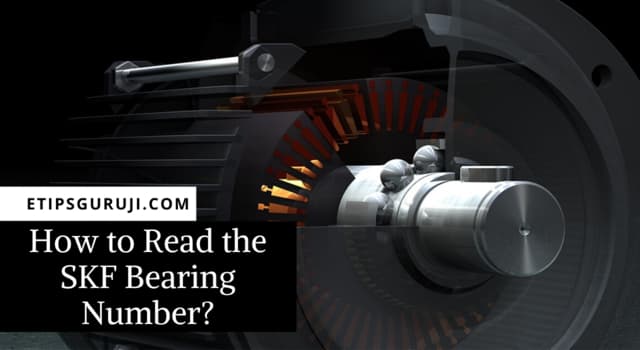
In an SKF bearing number, it consists of a basic designation with or without any supplementary values i.e. bearing type along with basic design or bearing size. In a general scenario, the complete bearing number is written on the package.
And with the written number on the SKF bearing package, you can easily depict various values such as
- SKF Bearing Type
- SKF Basic Design
- Boundary Dimensions
To read the SKF bearing number for different types of bearing, you just have to follow the below-listed table.
| S.No. | SKF Bearing Type | Type Code |
|---|---|---|
| 1 | Double row angular contact ball bearing | 0 |
| 2 | Self-aligning ball bearing | 1 |
| 3 | Spherical roller bearing, spherical roller thrust bearing | 2 |
| 4 | Tapered roller bearing | 3 |
| 5 | SKF double row deep groove ball bearing | 4 |
| 6 | Thrust ball bearing | 5 |
| 7 | SKF single row deep groove ball bearing | 6 |
| 8 | Single row angular contact ball bearing | 7 |
| 9 | Cylindrical Roller Thrust Bearing | 8 |
| 10 | CARB toroidal roller bearing | C |
| 11 | Cylindrical roller bearing. Two or more letters are used to identify the number of the rows or the configuration of the flanges, e.g. NJ, NU, NUP, NN, NNU, NNCF, etc. | N |
| 12 | Four-point contact ball bearing | QJ |
| 13 | Tapered roller bearing | T |
Like other bearing numbers, the SKF bearing number’s first digit or the letter states the type of bearing and its basic variants.
After that, the next two digits state the ISO dimension series in which the first digit represents the width while the second digit represents the diameter of the bearing.
Moreover, the next two digits of the SKF bearing number consist of size code and bearing code. Also, when the size code is multiplied by 5 it gives the bore diameter in mm.
People Also Read:
- Casing and Capping Wiring- 4 Basic Type & Installation Guide
- How to Test Capacitors – Its Methods, Functions, and Types
- How to Hotwire a Car? | 3 Best-Known Cheat to Hotwire a Car
With this, our post on how to identify bearings by number ends, now these are the following frequently asked questions that people generally search on google.
General FAQs
How to identify bearings by number?
Finding a bearing number is easy. In general, a bearing number has a total of 6 characters (4 digits 2 alphabets). The first letter represents the bearing type, the second number represents the bearing series, the 3rd and 4th number represents the bore size while the last two alphabets represent the seal/ shielding/ no-sealing markers.
What size is the 6203 bearing?
While interpreting the size from a bearing number the second digit represents the bearing size. Therefore, in this case, the number ‘2’ represents the bearing size in mm which is 15mm.
What do numbers on a bearing mean?
The number on a bearing is usually not a bearing number but a reference bearing number which can be used to interpret the real bearing number.
How do you read bearing sizes?
In a bearing number, the 3rd and 4th numbers indicted the bearing size if the bearing number is of 4 digits. But when the bearing number is of 3 digits then the 3rd number represents the bearing size.
